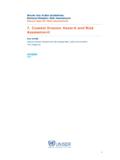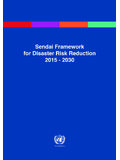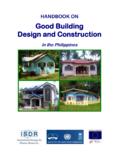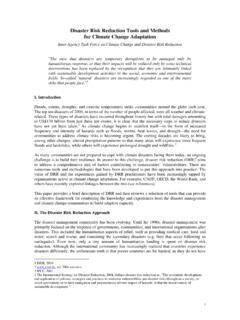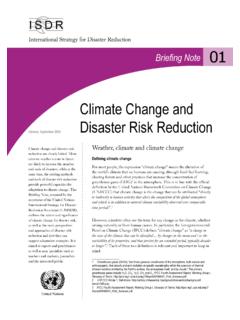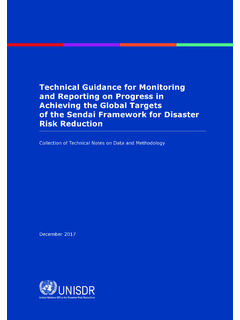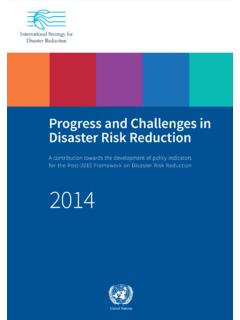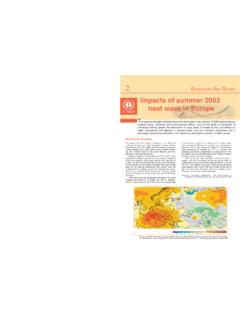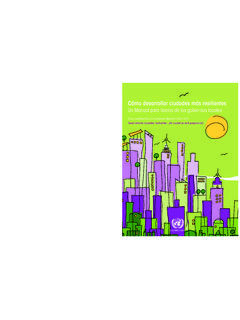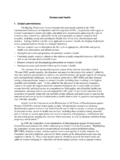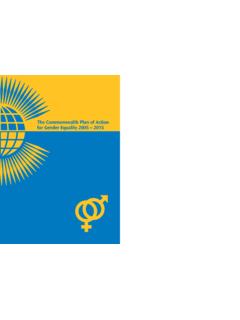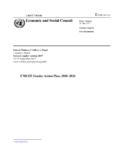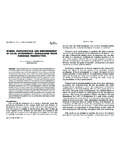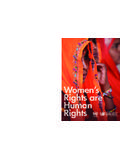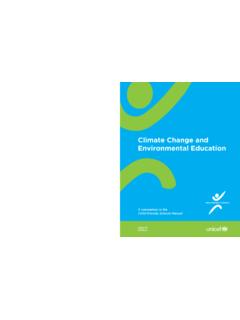Transcription of Making Disaster Risk Reduction Gender-Sensitive - …
1 Making Disaster Risk Reduction gender -SensitivePolicy and Practical GuidelinesMaking Disaster Risk Reduction Gender-Sensitive : Policy and Practical Guidelines iiMaking Disaster Risk Reduction gender -SensitivePolicy and Practical GuidelinesPublised by UNISDR, UNDP and IUCN. Geneva, Switzerland, June 2009. United Nations, 2009 UNISDR, UNDP and IUCN, 2009 All rights reserved Any part of this text may be reproduced without permission provided that it is reproduced accurately and not in a misleading context and the source of the material is clearly acknowledged by means of the above title, publisher and date.
2 The wide dissemination, reproduction and use of the document is encouraged. If any reproductions, translations or quotations are generated, a copy of the document or quotation is requested to be forwarded to : Fresco of Jos Venturelli School of Balexert Collection of the Commune of Vernier Geneva, Switzerland Photo: Henrik ThorlundThis first version of Making Disaster Risk Reduction Gender-Sensitive Policy and Practical Guidelines will be subject to consultations for further improvement. We welcome inputs, insight and experiences from readers, implementing partners and other stakeholders.
3 Please provide your feedback to: Disaster Risk Reduction Gender-Sensitive : Policy and Practical GuidelinesiiiAcknowledgementsUNISDR gratefully acknowledges the contributions made to this publication by different stakeholders of the UNISDR System. The publication is a result of a collaborative effort of the gender Working Group on Disaster Risk Reduction , facilitated by Committee: Lorena Aguilar (IUCN), Feng Min Kan (UNISDR), Madhavi Ariyabandu (UNISDR), Rowena Hay (Umvoto Africa ), Lucita Lazo (CAPWIP) and Ana Cristina Angulo Thorlund (UNISDR).Contributors: Cheryl Anderson (University of Hawaii), Meenakshi Ahluwalia, Itza Casta eda , Xavier Moya, Rafael Van Dyck (UNDP), Maureen Fordham (University of Northumbria) and Tracy Raczek (UNIFEM).
4 Our particular thanks go to Andrea Quesada Aguilar who provided the initial research, analysis and outline for the chapters, to Adelia Branco who provided the initial review of national s reports to UNISDR and to Tze Ming Mok for helping to shape the publication with substantial editorial advice and analytical input. This publication has also benefited from in-depth discussions at two international forums: The Third Global Congress on Women in Politics held in 2008 in Manila, organized by the Center for Asia-Pacific Women in Politics; and the International Conference on gender and Disaster Risk Reduction held in 2009 in Beijing, organized by the All China Women s Federation, in collaboration with publication was produced under the guidance and supervision of Feng Min Kan, coordinated by Ana Cristina Angulo Thorlund, and designed and layout by Ramon Valle and Mario Barrantes with support from Lydie Echernier and Sylvain Ponserre of UNISDR Information Management was prepared in respond to the request of governments attending the First Session of the Global Platform for Disaster Risk Reduction in 2007.
5 The publication is also part of the UNISDR Biennial Work Plan 2008-2009, which was supported by the United Nations Trust Fund for Disaster Reduction and the Global Facility for Disaster Reduction and Recovery of the World Bank. Making Disaster Risk Reduction Gender-Sensitive : Policy and Practical Guidelines ivPrefaceDisasters don t discriminate, but people do. Existing socio-economic conditions mean that disasters can lead to different outcomes even for demographically similar communities - but inevitably the most vulnerable groups suffer more than others. Research reveals that disasters reinforce, perpetuate and increase gender inequality, Making bad situations worse for women.
6 Meanwhile, the potential contributions that women can offer to the Disaster risk Reduction imperative around the world are often overlooked and female leadership in building community resilience to disasters is frequently disregarded. IUCN, UNDP and UNISDR have been working jointly to integrate gender issues into Disaster risk Reduction across the board. For IUCN, the growing impact of climate change-related disasters on women is of immense concern. Meanwhile, UNDP s Eight Point Agenda for Women s Empowerment and gender Equality in Crisis Prevention and Recovery, emphasizes the need to promote gender equality in Disaster risk Reduction initiatives and to support women and men to build back better.
7 This joint publication is a result of a UNISDR-led process supporting implementation of the Hyogo Framework for Action 2005-2015: Building the Resilience of Nations and Communities to Disasters (HFA). Making Disaster Risk Reduction Gender-Sensitive : Policy and Practical GuidelinesvThis pivotal publication offers much-needed policy and practical guidelines for national and local governments to further implement the HFA. Disaster risk Reduction that delivers gender equality is a cost-effective win-win option for reducing vulnerability and sustaining the livelihoods of whole communities.
8 Urgent risk Reduction action from the global to the local level is also crucial for tackling climate change adaptation, and for strengthening overall development gains in an integrated manner. We hope this landmark document will help reverse the slow and inconsistent progress thus far on confronting these pressing Wahlstr mAssistant Secretary-General for Disaster Risk ReductionUnited NationsJulia Marton-Lef vre Director General IUCN Jordan RyanAssistant Administrator and DirectorBCPR, UNDPM aking Disaster Risk Reduction Gender-Sensitive : Policy and Practical Guidelines viIntroductionGender mainstreaming is a concept that most find easy to agree with, but fewer consistently do well.
9 The same can be said of Disaster risk Reduction . When these two issues are brought together in efforts to mainstream gender into Disaster risk Reduction , governments and practitioners have found a gap in policy and practical guidance. They know why they should do it, but not always how. This is not because the task is inherently difficult; rather, there is not enough precedent guidance and practical respond to this, UNISDR has stepped up its efforts in support of mainstreaming gender perspectives into Disaster risk Reduction since 2006. This publication is the result of extensive consultations and a response to the call for clear policy and practical guidance for mainstreaming gender perspectives into Disaster risk process included an initial review of government reports and reports from major conferences on gender and Disaster management or Reduction since 2002, organization of two consultative meetings with experts in 2007 and 2008.
10 Introduction of the issue to national governments at the first Global Platform for Disaster Risk Reduction in 2007, and further and wider discussion of gender and Disaster risk Reduction at the Third International Congress of Women in Politics on gender , Climate Change and Disaster Risk Reduction in October 2008, and the International Conference on gender and Disaster risk Reduction in April 2009. Making Disaster Risk Reduction Gender-Sensitive : Policy and Practical GuidelinesviiOur overarching goal is to contribute to building the Disaster resilience of both women and men, in order to achieve sustainable development.
